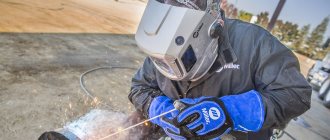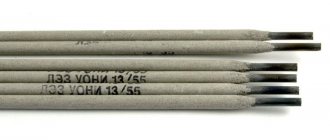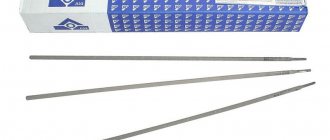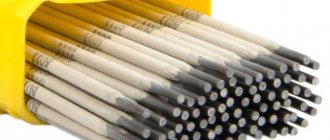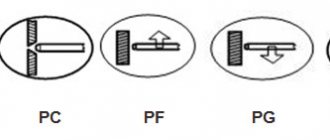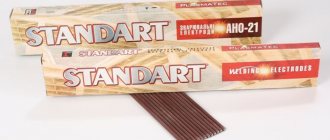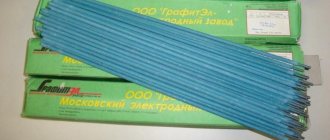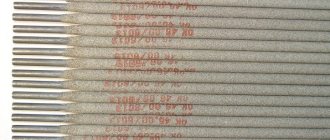Modern construction cannot be imagined without welding work. Today there are many types of welding. The new era of glass and metal dictates its own requirements for welding materials. One of the most common types is manual arc welding using a coated electrode. And one of the most common ones are electrodes of the UONI-13/55 brand.
Most experienced and novice welders have encountered UONI-13/55 electrodes. And if welders who have been working for several years speak positively about this brand of welding materials, beginners often cannot appreciate these products. But everything comes with experience, and the skills acquired during work allow the use of such electrodes as the main consumable material.
What are UONI-13/55 electrodes?
This type of product is a rod made of Sv-08A wire with a coating applied to it. The coating of these electrodes according to GOST 9466-75 is of the basic type. The electrode is designed for connecting metal products during the welding process. When a high temperature welding arc is generated between the anode and cathode using a power source. This in turn contributes to the melting of the electrode itself and the metal of the workpiece, as well as their mixing. In the process, a weld is formed that connects the parts to be welded.
Purpose and technical characteristics
These electrodes are intended for welding critical structures made of carbon and low-alloy steels. They belong to type E50A, which means that such products can be used to weld metals with a tensile strength of up to 50 kgf/mm2. The use of a basic type of coating helps to obtain a high-quality and durable seam that is resistant to the formation of crystallization cracks and contains a small amount of hydrogen. Such products are used in welding oil and gas pipelines, as well as bridges and other critical structures.
The weld metal made by this type of electrode is resistant to alternating loads (compression - tension). This brand is recommended for welding parts and elements operating at low temperatures. Widely used in construction work in northern regions. They have a productivity of 9.5 g/Ah and a consumption coefficient of 1.65. The relative elongation is in the range of 25-30%, and the impact strength is 24-28 kgf*m/cm2. The composition of the coating includes manganese, silicon, carbon, phosphorus and sulfur. In construction, UONI-13/55 electrodes with a diameter of 2.5 to 6.0 mm are used.
general information
E50a electrodes are intended for welding particularly critical metal structures made of carbon steel with a low content of alloying elements in the composition. The resulting seams are designed for use in conditions of high and low temperatures. The compounds are plastic and viscous. This characteristic is especially evident during mechanical shocks. Most often, electrodes of this type are used in shipbuilding, as well as in the nuclear industry.
Decoding
E50A is not just a set of numbers and letters. This is a name with information encrypted in it.
The letter “E” indicates that this type of electrode is intended for manual arc welding with coated electrodes. The numbers 5 and 0 are the tensile strength value. Using this number, you can calculate the loads that the seam can withstand. And this is extremely important when welding load-bearing structures. For example, farms. The letter “A” indicates that the finished seam will have increased ductility and viscosity.
Electrode brands
Type E50A includes brands TMU-50, MTG-02, MTG-01K, TsU-5, OZS-18, ANO-TM, TsU-5M, DSK-50U, TMU-21U, OZS-25, E-138/50N .. These are commonly used brands. In fact, there are many more of them.
These brands are domestically produced and have similar characteristics. Each brand is based on either Sv-08 or Sv-08A wire. In most cases, the coverage is basic. Therefore, the chemical composition of all these brands is similar. Choose the one that suits your price and that you can easily buy at your nearest store.
These electrodes have different names but have relatively the same composition. This is due to manufacturers who develop their brands and name them in accordance with their classification principles. But. Despite the differences in name, the chemical composition remains the same. So the result will be approximately the same, no matter which brand you choose.
Why is it difficult for beginners to work with such electrodes?
It's all about the type of coating. Products with the basic type of coating, unlike rutile electrodes, require calcination and strict adherence to storage conditions. Otherwise, moisture accumulated in the coating will complicate the work and deteriorate the quality of the connection. The second feature of this type of coating is that re-ignition is difficult. Experienced welders solve this problem by simply breaking off the remaining coating at the end of the electrode so that the metal of the rod can contact the workpiece. An important factor is the choice of welding current. At low values of the latter, the electrode may “stick”. In this case, it is worth increasing the current to comfortable levels. It should also be noted that welding is performed only with a short arc on the cleaned surface. Devices capable of delivering direct current of reverse polarity are suitable as a power source. These nuances apply not only to UONI-13/55 electrodes, but to all products with the main type of coating.
Acid coated electrodes.
The basis of this type of coating is oxides of iron, manganese and silicon. Weld metal made with acid-coated electrodes has an increased tendency to form hot cracks. According to the mechanical properties of the weld metal and welded joint, the electrodes belong to the E38
and
E42.
Acid-coated electrodes are not prone to pore formation when welding metal covered with scale or rust, or when the arc is extended. Welding can be performed with direct and alternating current.
Electrodes with rutile coating.
The coating of such electrodes is based on rutile concentrate (natural titanium dioxide). The weld metal, made with rutile-coated electrodes, corresponds to mild or semi-mild steel. The resistance of the weld metal against the formation of cracks in electrodes with a rutile coating is higher than that of electrodes with an acid coating. According to the mechanical properties of the weld metal and welded joint, most brands of rutile electrodes belong to the E42
and
E46
.
Rutile electrodes have a number of advantages compared to other types of electrodes, namely, they provide stable and powerful arc combustion when welding with alternating current, low metal loss due to spattering, easy separation of the slag crust, and excellent weld formation. Electrodes are little sensitive to the formation of pores when changing the arc length, when welding wet and rusty metal and on an oxidized surface.
The electrodes of this group also include electrodes with ilmenite coating, which occupy an intermediate position between electrodes with acidic and rutile coatings. The main component of the coating of these electrodes includes ilmenite concentrate (a natural compound of titanium and iron dioxides).
Electrodes with basic coating.
The basis of this type of coating is carbonates and fluoride compounds. The metal deposited with electrodes with a basic coating corresponds in chemical composition to mild steel. Due to the low content of gases, non-metallic inclusions and harmful impurities, the weld metal made with these electrodes is characterized by high ductility and impact strength at normal and low temperatures, and also has increased resistance to the formation of hot cracks. According to the mechanical properties of the weld metal and welded joints, electrodes with a basic coating belong to electrodes of type E42A, E46A, E50A, E55
and
E60.
At the same time, in terms of technological characteristics, electrodes with a basic coating are inferior to other types of electrodes. They are very sensitive to the formation of pores in the presence of scale, rust and oil on the edges of the parts being welded, as well as when the coating is moistened and the arc is extended. Welding is usually carried out with direct current of reverse polarity. Before welding, electrodes must be calcined at high temperatures (250-4200C).
Electrodes with cellulose coating.
This type of coating contains a large amount (up to 50%) of organic components, usually cellulose. Metal deposited with cellulose electrodes has the same chemical composition as semi-quiet or mild steel. At the same time, it contains an increased amount of hydrogen. In terms of the mechanical properties of the weld metal and welded joints, electrodes with cellulose coating correspond to electrodes E42, E46
and
E50.
Cellulose electrodes are characterized by the formation of a uniform back seam bead during one-sided suspended welding, and the ability to weld vertical seams using a top-down method.
All electrodes described above, intended for welding carbon and low-alloy steels, with any type of coating must meet the requirements of GOST 9466-75
and
GOST 9467-75,
as well as the requirements of technical specifications for electrodes. The technical specifications may contain additional requirements that are necessary to more efficiently conduct the process and/or obtain welded joints with special characteristics and increased operational reliability.
Electrodes for welding carbon and low-alloy structural steels
| Electrode brand | Type according to GOST 9467-75 | Diameter, mm | Welding position | Type of welding current |
| 1 | 2 | 3 | 4 | 5 |
| OZS-41 | E38 | 3,0; 4,0;5,0 | Everything except vertical from top to bottom | variable, constant |
| OZS-42 | E42 | 3,0; 4,0; 5,0 | Everything except vertical from top to bottom | variable, constant |
| OZS-12I/42 | E42 | 3,0; 4,0; 5,0 | Everything except vertical from top to bottom | variable, constant |
| OMA-2 | E42 | 2,0; 2,5; 3,0 | All | variable, constant |
| Ogonyok | E42 | 2,0 | All | variable, constant |
| OZS-23 | E42 | 2,0; 2,5;3,0 | Everything except vertical from top to bottom | variable, constant |
| UONI-13/45 | E42A | 2,0; 2,5; 3,0; 4,0; 5,0 | Everything except vertical from top to bottom | constant |
| OZS-3 | E46 | 3,0; 4,0; 5,0 | Lower | variable, constant |
| OZS-4 | E46 | 3,0; 4,0; 5,0 | Everything except vertical from top to bottom | variable, constant |
| OZS-4I | E46 | 3,0; 4,0; 5,0 | Everything except vertical from top to bottom | variable, constant |
| OZS-6 | E46 | 3,0; 4,0; 5,0 | Everything except vertical from top to bottom | variable, constant |
| OZS-12 | E46 | 2,0; 2,5; 3,0; 4,0; 5,0 | All | variable, constant |
| OZS-12I | E46 | 3,0; 4,0; 5,0 | Everything except vertical from top to bottom | variable, constant |
| OZS-21 | E46 | 3,0; 4,0; 5,0 | Everything except vertical from top to bottom | variable, constant |
| UONI-13/55K | E46A | 3,0; 4,0; 5,0 | Everything except vertical from top to bottom | constant |
| UONI-13/55 | E50A | 2,0; 2,5; 3,0; 4,0; 5,0 | Everything except vertical from top to bottom | constant |
| UONI-13/55T | E50A | 3,0; 4,0; 5,0 | Everything except vertical from top to bottom | variable, constant |
| UONI-13/55G | E50A | 3,0; 4,0 | Everything except vertical from top to bottom | constant |
| OZS-28 | E50A | 3,0; 4,0; 5,0 | All | variable, constant |
| OZS-33 | E50A | 3,0; 4,0; 5,0 | Everything except vertical from top to bottom | variable, constant |
| UONI-13/65 | E60 | 2,0; 2,5; 3,0; 4,0; 5,0 | Everything except vertical from top to bottom | constant |
| VI-10-6/Sv-08A | E60 | 2,0; 2,5; 3,0; 4,0; 5,0 | Everything except vertical from top to bottom | constant |
Electrodes for welding carbon and low-alloy structural steels for specialized applications.
| Electrode brand | Type according to GOST 9467-75 | Diameter, mm | Welding position | Type of welding current | Application area |
| 1 | 2 | 3 | 4 | 5 | 6 |
| OZS-17N | E46 | 4,0; 5,0 | Lower | variable | Inclined electrode welding |
| OZS-30 | E46 | 4,0; 5,0 | Everything except vertical from top to bottom | variable, constant | Welding of hot-dip galvanizing baths |
| OZS-32 | E46 | 3,0; 4,0 | Everything except vertical from top to bottom | variable, constant | Welding of galvanized steels |
| OZS-18 | E50A | 3,0; 4,0; 5,0 | Everything except vertical from top to bottom | constant | Welding of atmospheric-corrosion-resistant steels type 10KhNDP |
| OZS-25 | E50A | 2,5; 3,0; 4,0; 5,0 | Everything except vertical from top to bottom | constant | Welding of steels ensuring cold resistance of the weld metal down to a temperature of minus 400C |
| OZS/VNIIST-27 | E55 | 3,0; 4,0 | Everything except vertical from top to bottom | constant | Welding of steels ensuring cold resistance of the weld metal down to a temperature of minus 600C |
| OZS-29 | E50A | 4,0; 5,0 | Everything except vertical from top to bottom | constant | Welding of steels ensuring cold resistance of the weld metal down to a temperature of minus 600C |
| OZS-24M | E60 | 3,0; 4,0 | Everything except vertical from top to bottom | constant | Welding of steels ensuring cold resistance of the weld metal down to a temperature of minus 700C |
| UONI-13/55U | E55 | 3,0; 4,0; 5,0 | Everything except vertical from top to bottom | variable, constant | Welding of reinforcement bars of reinforced concrete structures and rails |
| VSC-4M | E42 | 4,0 | All | constant | Welding of pipeline joints |
| TMU-21U | E50A | 3,0; 4,0; 5,0 | Everything except vertical from top to bottom | constant | Welding of pipeline joints |
| VSF-65U | E60 | 4,0; 5,0 | Everything except vertical from top to bottom | constant | Welding of pipeline joints |
Manufacturers
Today there are a large number of manufacturers of welding electrodes. For example, on the website of the Shadrinsky Electrode Plant goodel.ru there are UONI-13/55 welding electrodes of all diameters, as well as more than 100 brands of other welding materials.
When choosing a manufacturer, it is also recommended to pay attention to the availability of certificates confirming the quality and results of mechanical and chemical tests. Typically, these studies are carried out for each batch of electrodes to ensure compliance with GOST requirements.
